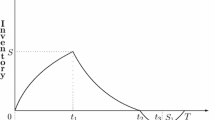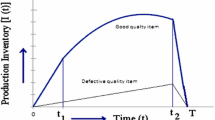Abstract
This paper proposes a production-inventory model with defective items. The model incorporates additional investment opportunity on quality improvement for reducing the proportion of defective products. Defective proportion depends upon production rate and the amount of this additional investment on quality improvement. Shortages are allowed and are fully backlogged. Only a random proportion of defective items can be resold at a highly discounted price and rest are to be disposed. Demand rate is assumed to be dependent on selling price. Unit cost is assumed to be a decreasing function of production rate. Profit maximization criterion is used to develop the model. The model jointly determines the optimum values of additional investment, selling price, production rate, production cycle, and production period. Concavity of the expected average net profit is proved. An iteration-based simple algorithm is provided to solve the developed model. The model is illustrated by a numerical example. A sensitivity analysis has been performed.



Similar content being viewed by others
References
Ben-Daya M, Hariga M, Khursheed SN (2008) Economic production quantity model with a shifting production rate. International Transactions in Operational Research 15:87–101
Chiu YP (2003) Determining the optimum lot size for the finite production model with random defective rate, the rework process, and backlogging. Engineering Optimization 35:427–437
Chung KJ, Hou KL (2003) An optimal production run time with imperfect production processes and allowable shortages. Comput Oper Res 30:483–490
Datta TK (2010) Production rate and selling price determination in an inventory system with partially defective products. IST Transactions in Applied Mathematics-Modeling and Simulation 1:15–19
Datta TK (2013) An inventory model with price and quality dependent demand where some items produced are defective. Advances in Operations Research. doi:10.1155/2013/795078
Dey O, Giri BC (2014) Optimal vendor investment for reducing defect rate in a vendor–buyer integrated system with imperfect production process. Int J Prod Econ 155:222–228
Eroglu A, Ozdemir G (2007) An economic order quantity model with defective items and shortages. International Journal of Production Economics 106:544–549
Goyal SK, Cardenas-Barron LE (2002) Note on economic production quantity model for items with imperfect quality—A practical approach. International Journal of Production Economics 77:85–87
Hayek PA, Salameh MK (2001) Production lot sizing with the reworking of imperfect quality items produced. Production Planning and Control 12(584):590
Hsu JT, Hsu LF (2013) An EOQ model with imperfect quality items, inspection errors, shortage backordering, and sales returns. International Journal of Production Economics 143:162–170
Khan M, Jaber MY, Bonney M (2011) An economic order quantity(EOQ) for items with imperfect quality and inspection errors. International Journal of Production Economics 133:113–118
Kim CH, Hong Y (1999) An optimal production run length in deteriorating production processes. International Journal of Production Economics 58:183–189
Lai X, Chen Z, Giri BC, Chiu CH (2015) Two-echelon inventory optimization for imperfect production system under quality competition environment. Mathematical Problems in Engineering. doi:10.1155/2015/326919
Lo ST, Wee HM, Huang WC (2007) An integrated production-inventory model with imperfect production processes and Weibull distribution deterioration under inflation. International Journal of Production Economics 106:248–260
Mandal P, Giri BC (2015) A single-vendor, multi-buyer integrated model with controllable lead time and quality improvement through reduction of defective items. Int J Syst Sci 2:1–14
Mondal B, Bhunia AK, Maiti M (2009) Inventory models for defective items incorporating marketing decisions with variable production cost. Appl Math Model 33:2845–2852
Papachristos S, Konstantaras I (2006) Economic ordering quantity models for items with imperfect quality. International Journal of Production Economics 100:148–154
Porteas EL (1986) Optimal lot sizing, process quality improvement and setup cost reduction. Oper Res 34:137–144
Rosenblatt MJ, Lee HL (1986) Economic production cycles with imperfect production processes. IIE Trans 18:48–55
Salameh MK, Jaber MY (2000) Economic production quantity model for items with imperfect quality. International Journal of Production Economics 64:59–64
Sana SS (2010) An economic production lot size model in an imperfect production system. Eur J Oper Res 201:158–170
Sarkar B, Gupta H, Chaudhuri KS, Goyal SK (2014) An integrated inventory model with variable lead time, defective units and delay in payments. Appl Math Comput 237:650–658
Sivashankari CK, Panayappan S (2014) Production inventory model with reworking of imperfect production, scrap and shortages. International Journal of Management Science and Engineering Management 9:9–20
Uthayakumar R, Palanivel M (2014) An inventory model for defective items with trade credit and inflation. Production & Manufacturing Research 2:355–379
Wee HM, Yu J, Chen MC (2007) Optimal inventory models for items with imperfect quality and shortage backordering. Omega 35:7–11
Acknowledgments
The author is grateful to anonymous referees for their constructive comments.
Author information
Authors and Affiliations
Corresponding author
Rights and permissions
About this article
Cite this article
Datta, T.K. Inventory system with defective products and investment opportunity for reducing defective proportion. Oper Res Int J 17, 297–312 (2017). https://doi.org/10.1007/s12351-016-0227-z
Received:
Revised:
Accepted:
Published:
Issue Date:
DOI: https://doi.org/10.1007/s12351-016-0227-z




